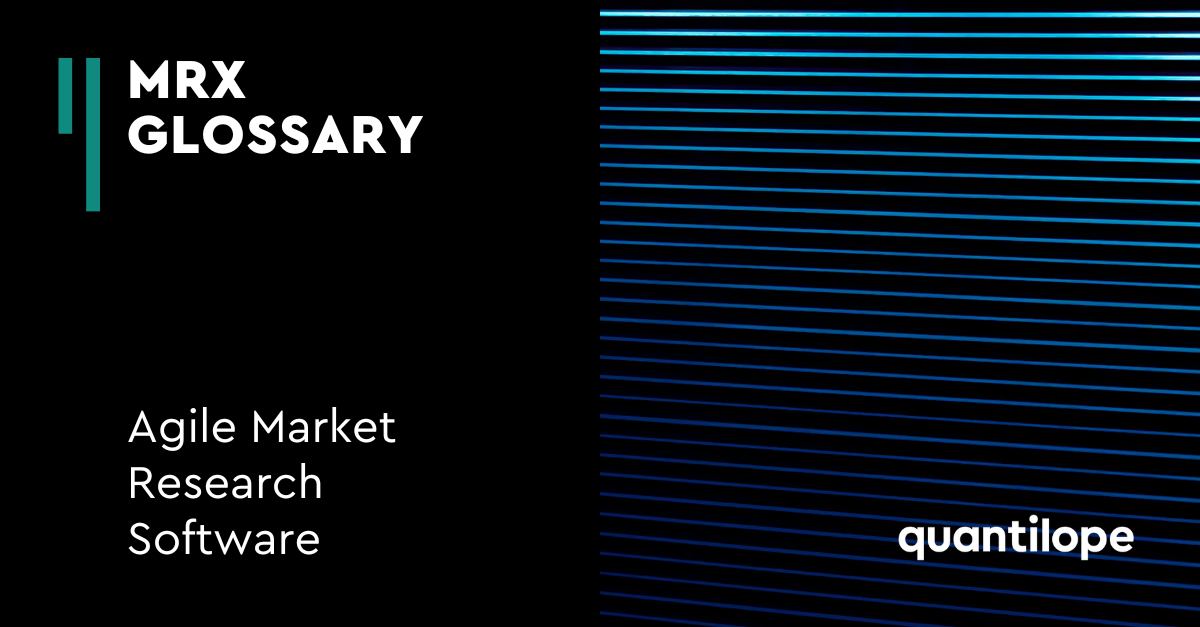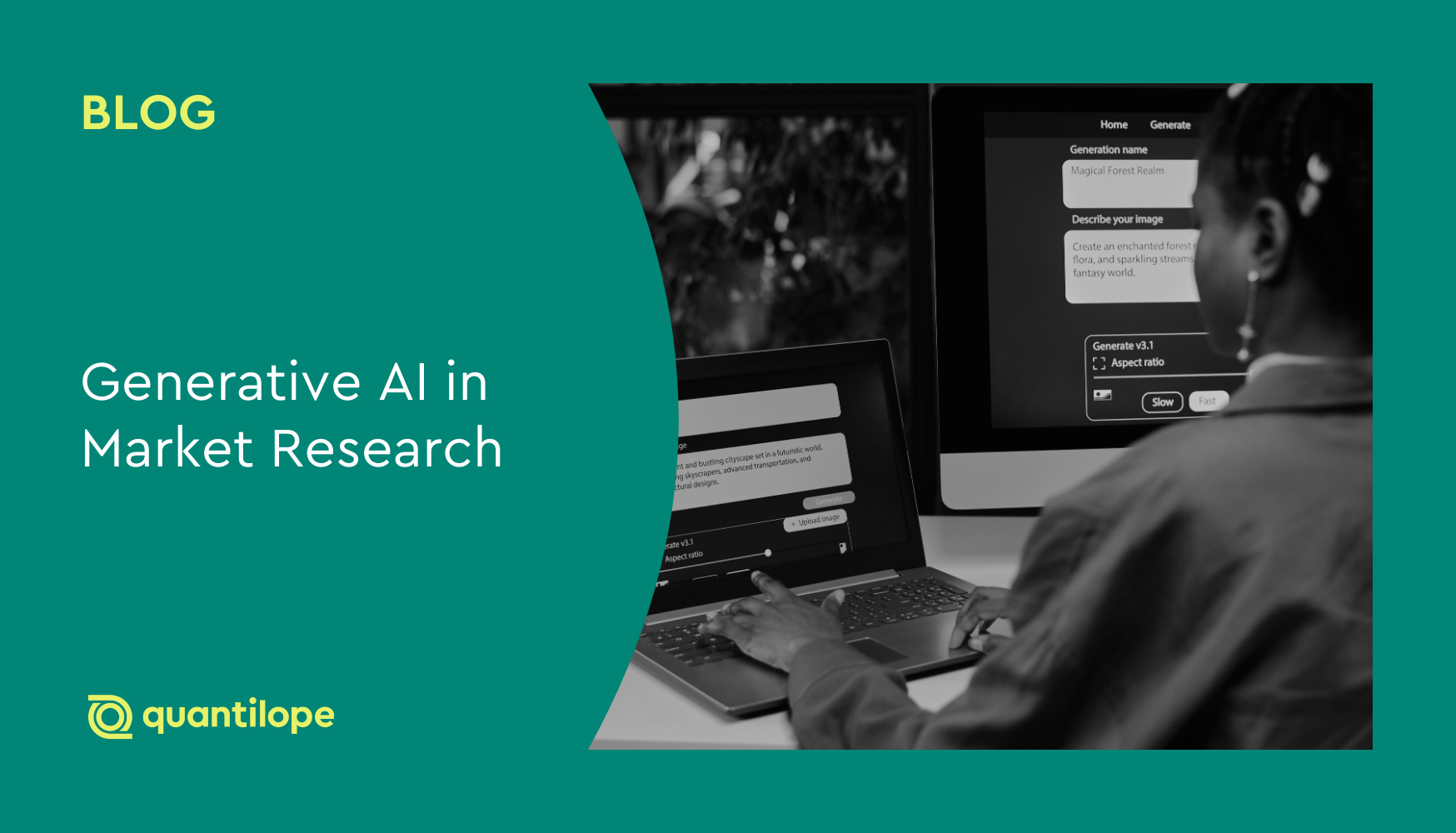Agile approaches to market research have been gaining momentum in recent years, and for a good reason. Read on to find out how agile market research generates a highly efficient research process, more informed decision-making, and greater value for businesses.
Table of Contents:
- What is agile research?
- Types of agile research
- Benefits of agile market research
- Elements of agile research
- quantilope's agile market research software
- Summary
What is agile research?
Agile market research is a streamlined, adaptable, and cost-effective way of conducting research, often enabled by automated software. It is highly flexible in terms of sampling, methodologies used, analysis, and reporting.
In contrast to traditional market research - where projects are briefed with an external agency and data is captured and processed over the course of several weeks, an agile research process follows a much less rigid structure.
Agile market research is an iterative process that builds on insights in short timeframes to get the most out of consumer feedback. With agile projects, researchers have access to all aspects of a study so they can make changes to the sample, the questionnaire, or the analysis at any stage within a project’s timeline. Data is also available in real-time, so with each new iteration of a study, teams can encompass learnings from previous rounds of research for quick, data-backed business decisions.
Agile market research is beneficial in multiple dimensions. With agile software developments cutting down the time needed to gather, analyze, and digest data - and with a research team in control of the process at every stage for real-time, actionable results, it is a noticeable improvement from traditionally slow research approaches.
To visualize how agile research works in a true context, let’s imagine that an energy drink company would like to understand how its product is perceived, what the category needs are, and how the company could leverage opportunities within its target market. This company would use an iterative framework comprised of four major stages or ‘sprints’, the first being to ‘explore’.
Explore
The first sprint of agile research is the explore stage which aims to identify consumer needs, attitudes, usage, and other trends that paint a picture of how the category looks. For the energy drink company, market insights at this stage reveal what consumers are looking for when they purchase an energy drink, which existing needs are unmet, and the occasions on which consumers drink energy drinks. This sprint can also identify perceptions of the client’s and/or competitors’ brands. The explore stage creates a springboard of ideas for the next sprint - to test.
Test
At this point, the energy drink company would present its ideas and concepts designed around unmet needs to consumers who represent its target audience. They’d gather feedback on different aspects of the concepts - including appeal, relevance, uniqueness, and usage intentions. For efficiency, it’s best to test more than one concept at this point, with the preferred concepts taken quickly into the next sprint - validation.
Validate
In the validation stage, the energy drink company will fine-tune its concepts to reflect learnings from the ‘test’ sprint and reshow the concepts to its target audience. For example, the test sprint may have identified a preference in packaging design, bottle size, flavor options, or price point. The company will create new concepts with this feedback in mind to prepare for the final stage of agile research- optimization.
Optimize
This stage aims to finalize an idea or concept that is optimal for market launch. By now, the energy drink company has enough consumer feedback from each of the preceding sprints to know what will resonate with its target audience and what will not. At the end of this stage, there will be one or more final concepts that are ready to take into production.
Hopefully, this example of the energy drink company portrays a real-life example of how to benefit from agile market research. Keep in mind though that agile market research isn’t limited to new product concept testing - the above framework can also be used when developing advertising campaigns, services, websites, communication materials, and so on.
Back to Table of Contents
Types of agile research
Agile research is possible through both quantitative and qualitative approaches:
Quantitative agile research
Quantitative research can be conducted using online agile research platforms and is most effective if the platform offers a range of quantitative methodologies and analysis tools. Some methodologies to look for in these platforms include Conjoint Analysis (to understand the importance of various aspects of a product or service when making a purchase decision), MaxDiff (to understand the trade-offs people make when choosing between items), Key Driver Analysis (to explore what motivates consumers in their purchase choice), TURF (to identify which mix of products reaches the most people in a brand’s portfolio) or Price Sensitivity Meter (to pinpoint the optimal price for a product or service).
Using agile research for any of the above quantitative methods, or, a combination of multiple methods, means brands can capture a series of findings, tailoring details down each time until they’ve optimized their insights.
Qualitative agile research
Qualitative research is essential for exploring the deeper feelings and motivations that trigger consumer decisions. Qual adds context to consumer responses, often turning up issues that a business might not have even anticipated asking in a quantitative manner. Qual is also often used as a precursor to quantitative research, incorporating consumer terminology and language into quantitative questions.
An agile platform that offers qual may be able to gather a series of video surveys (where respondents answer in video form - either individually or as part of an online group). The agility comes into play as brands reflect on consumers’ feedback to reframe new questions for even more tailored answers in a very quick turnaround.
Back to Table of Contents
Benefits of agile market research
Speed of insights is the obvious benefit of agile research compared to traditional market research approaches, though the benefits don’t stop there. While agile research does indeed expedite things like product development and communication testing, it also delivers high-quality, findings in an affordable, yet collaborative and actionable way.
Below are some additional benefits that come from agile market research:
A real-time understanding of customer views
Consumers interact with an overwhelming number of advertising messages, brands, and promotional materials every day, and from one day to the next, their opinions might shift.
With this in mind, a flexible, fast research approach is necessary to keep up with consumer attitudes in real-time, pinpointing trends as they take off. The iterative nature of agile research taps into this fluidity of consumer needs, arming businesses with the insights they need to respond accordingly and stay ahead of the competition - whether it’s product development, branding efforts, or communication design.
Collaboration
One of the great benefits of agile insights is the opportunity for cross-team collaboration. All stakeholders are able to access a dashboard on an agile insight platform, thereby sharing data and insights across departments. All team members can post suggestions, respond to others, and take action on given feedback. In this way, the voices of all involved teams and stakeholders are represented in a final deliverable, minimizing the rounds of edits required.
Cost efficiency
Agile insights projects save time and labor, so they are much cheaper to run than traditional market research projects. Research teams can create and launch a survey themselves (cutting down costs for external programmers), monitor responses, and view findings within days - all without requiring help from outsourced trams. Most agile insights platforms also automate data processing, methodologies, and reporting, removing the need to pay for data processing teams or report designers.
Back to Table of Contents
Elements of agile market research
Agile market research is a combination of processes that allow for speed, adaptability, and ideally, direct control for the research team. Some elements to look out for when searching for an agile software solution:
-
an online platform that can handle all aspects of the research, from survey creation to the presentation of findings (and all steps in between)
-
time-saving tools such as questionnaire templates
-
panel agnostic capabilities for seamless recruitment
-
real-time access to the data
-
automated analysis and reporting
-
customizable charting capabilities
-
an interactive dashboard where insights are displayed and easily shared out
quantilope’s agile market research software
quantilope’s agile market research platform offers an end-to-end solution to research so that stakeholders and research teams can access all insights in one place. Projects are stored for future reference, making it easy to circle back and iterate on consumer insights as needed.
quantilope’s approach to agile research is manageable, controllable, and flexible. Below are just a few elements researchers can expect with the Insights Automation Platform:
Custom survey design
quantilope enables users to design their survey with their own unique business needs in mind, via both a drag-and-drop survey builder as well as survey templates designed by insights professionals to ensure all the relevant issues are covered by the questionnaire. Both approaches (drag-and-drop or templated designs) are fully customizable, allowing brands to add their own phrasing, answer options, colors, images, and more.
Research teams also have customizable options when it comes to panels - thanks to quantilope’s panel agnostic functionality, allowing teams to reach consumers through any means they wish; this might be connecting to an online panel provider, or directing their own supplied list of participants to the survey. However you want to design and release your survey, quantilope makes it possible.
Real-time data
Responses to survey questionnaires are automatically analyzed as soon they come in and are instantly viewable in quantilope’s reporting tab. This means that clients can monitor how responses look as the study progresses and take early action to amend the questionnaire for the next research sprint. For example, a research team may notice that responses aren’t favorable toward one of their concept ideas. Rather than waiting for the survey to reach its conclusion, the team can already start brainstorming new concepts to introduce to its target audience in the next iteration of the study - thereby speeding up the overall research process.
Teams can add any analysis chart they want to monitor to a real-time dashboard, which updates automatically with any new data that comes in after initially creating the chart. This dashboard then serves as an always-updated resource hub for teams and stakeholders.
A suite of advanced research methodologies
quantilope offers a suite of 13 quantitative agile market research methodologies, ensuring clients with any research need can leverage a suitable advanced method. Any of these can be used for agile studies - such as an A/B test where brands can quickly measure concept ideas and change direction if needed, or a Price Sensitivity Meter where brands can monitor optimal price points and quickly make pricing decisions to stay ahead of their competition.
The use of these advanced methods requires no statistical background or in-depth market research knowledge. The platform’s pre-programmed library allows users to simply drag & drop a method into a questionnaire and customize it as needed. quantilope’s verified team of research consultants is also available throughout the entire market research process if needed.
In addition, quantilope’s dedicated online qualitative tool, inColor, brings findings alive through the magic of video. Respondents are asked to give their answers verbally, filming themselves on video so that insights teams can hear what they say as well as how they say it. Sentiment, keyword, and emotion analyses dig deeper into consumers’ true feelings and motivations so that researchers can understand what will really drive them to choose one offer over another.
Summary
quantilope was built with agile market research in mind. Automation makes online surveys quick and reliable so that brands can feel confident making business decisions grounded in data-driven consumer insights.
Ready to start your own agile market research project? Get in touch below to learn more!



.png)
